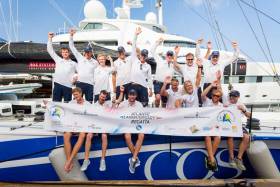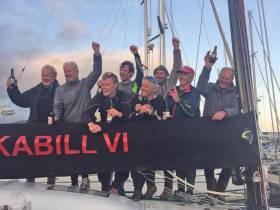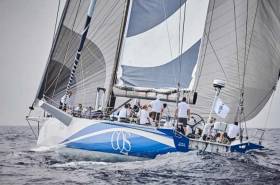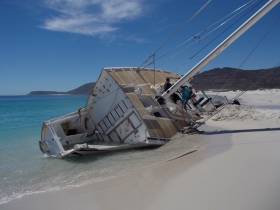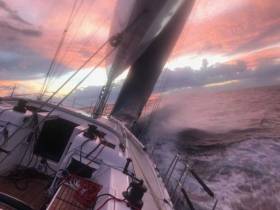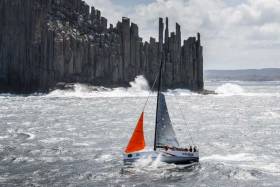Displaying items by tag: Offshore
Beneteau Announces Special Price For Class Members For New Figaro 3 Foiling Yacht
#Figaro - Following this summer’s first images of its new foiling one-design, Beneteau has announced the pricing for the Figaro 3.
And the French marque says it has kept its promise of an affordable boat, with a special price of €155,000 ex VAT for Figaro class members — a discount of €20,000 off the standard retail ticket.
The first 50 Figaro 3 yachts will be delivered in early 2019, with lots drawn to determine the hull numbers at next year’s Nautic Paris Boat Show.
French Teasing Machine is Overall Winner of 2017 RORC Transatlantic Race
Eric de Turckheim's French Nivelt-Muratet 54 Teasing Machine is the overall winner of the 2017 RORC Transatlantic Race. Whilst many of the record 23–yacht fleet are still racing, none of them can better Teasing Machine's corrected time under IRC. Teasing Machine is the smallest yacht to win the RORC Transatlantic Trophy which has been previously won by yachts in the Maxi Class.
"To win the RORC Transatlantic Race is just fantastic," commented Eric de Turckheim. "It is not just a personal achievement to win my first ever transatlantic race because it has been such a massive team effort. Teasing Machine was only taking part in its second offshore race and to build a team to that performance level within four months has required a huge commitment from everyone, but especially Laurent Pages."
Teasing Machine tactician Laurent Pagès and Navigator Jean-Luc Nélias form a formidable partnership. The Frenchman took the same roles for skipper Franck Cammas, winning the 2011-12 Volvo Ocean Race, and Nélias won this year's Transat Jacques Vabre on Sodebo Ultim with Thomas Colville, smashing the race record.
"There were three main stories to this book," explained Laurent Pagès. "The start of the course put us in the wind shadow of the Canary Islands which was very difficult, but we had a very good first 24 hours. It was very important to be as early as possible to the ridge of high pressure because the door would close at some stage, and we did a very good job crossing the area of light winds. After that we knew we would have to go south eventually and we tried to remain in the pressure. Teasing Machine is a powerful boat that likes to stay in the wind. It has been a privilege to discuss the strategy of the race with Jean-Luc Nélias. It is another great victory and I hope there will be many more."
RORC Chief Executive Eddie Warden Owen was very pleased with the result and the race: "It has been no easy task for the Teasing Machine team to win this race and they have been pushed hard by a number of very competitive boats. Eric and his team showed their determination and expertise, setting a strong pace from day one and never letting up. This race marks the start of the 2018 RORC Season's Points Championship and Teasing Machine has set the standard required for the rest of the fleet who have their eyes on this prestigious prize."
Kenefick & Espey Take Transatlantic Line Honours on CQS
Ludde Ingvall's Australian Maxi CQS finished the 2017 RORC Transatlantic Race on Wednesday 6th December taking Monohull Line Honours in an elapsed time of 11 days 00 hrs 03 mins 08 secs. CQS committed to a southerly route for the 3,000 nautical mile race and despite sustaining sail damage in a vicious 40 knot squall, the canting keel 98ft Maxi led from start to finish. Ingvall is no stranger to taking line honours in prestigious offshore races, twice taking the honour in both the Rolex Fastnet Race and the Rolex Sydney Hobart Yacht Race. This was Ludde Ingvall's 16th transatlantic.
Once dockside at Camper & Nicholsons Port Louis Marina, Ingvall was full of enthusiasm for the RORC Transatlantic Race and his team:
"We have had a fantastic trip, even though the slow start meant we didn't have a fast race, but I love it. It is great to be back in the Atlantic and especially nice to be first. Much more fun than being last! We have a young crew on board and it is especially rewarding to give them this chance and 'pass it on'. Sailing is an amazing sport, but big boat opportunities for young sailors are few and they did really well. Just think, we have eight nationalities on one boat and everybody was focused on the same finish line. We worked as a team, looked after each other and it was tough at times."
After the Australian Maxi had safely moored at the impressive Superyacht Dock, CQS received a warm welcome from RORC Race Officer Steve Cole and Glynn Thomas, General Manager at Camper & Nicholsons Port Louis Marina. Patricia Maher, Chief Executive Officer at Grenada Tourism Authority presented Ludde Ingvall and his team with a basket of Grenadian produce.
CQS has now set the bar for the best corrected time under IRC for the RORC Transatlantic Race Trophy. The defending champion, Marten 72 Aragon, skippered by Jochen Bovenkamp and Canadian Southern Wind 96 Sorceress, skippered by Daniel Stump are likely to be the next yachts to finish. The Maxis have close company from two high-performance offshore racing yachts, Tilmar Hansen's German Elliott 52 Outsider and the provisional overall leader, Eric de Turckheim's French Nivelt-Muratet 54 Teasing Machine. All four yachts are expected to finish the 2017 RORC Transatlantic Race on Friday 8th December.
Paul O’Higgins (RIYC) is November’s Afloat.ie “Sailor of the Month (Offshore)” for the sporting way he campaigns his JPK 10.80 Rockabill VI.
He knew when to make it serious to win the Volvo Dun Laoghaire to Dingle Race, but equally he won his class in Calves Week as part of a family holiday.
And he gallantly campaigns the DBSC Turkey Shoot as a front runner on the water, but carrying a stratospheric handicap.
Atlantic Knockdown for Kenefick & Espey on Ingvall's CQS
Irish sailors David Kenefick and James Espey on board Ludde Ingvall's CQS suffered a setback in the RORC Transatlantic Race; the westbound leg of the Atlantic Anniversary Regatta. "We got caught in a bad squall of probably 40 knots which resulted in a number of issues," Ingvall reported from on board on day 10 of the race. "There has been damage to sails and onboard electronic systems, but we are still progressing towards the finish."
Kenneth Thelen, co-skipper for Australian Maxi CQS confirmed that all of the crew of the 96ft canting keel Maxi were safe and well. Describing the damage he said: "Part of our electronics failed making it hard to sail in the dark. We blew our biggest spinnaker, but it is repairable. As we went into a gybe, the engine stalled and we lay flat on our side for a while which resulted in a diesel spill inside the boat, so the smell is terrible in the heat! We broke the top three battens in the mainsail, but we are still sailing towards the finish at reasonable speed, in pouring rain. We will assess the situation at first light."
At 1100 UTC on December 4th, the race tracker showed that CQS had slowed down to barely a few knots of boat speed to effect repairs. "We are back on track," continued Ingvall. We lost about six hours while sailing slowly and then stopped to repair probably at 90-95%, but we are now doing 14-15 knots average with G1 and a full main."
At the time of the incident CQS was more than 400 nautical miles ahead of Jochen Bovenkamp's Dutch Marten 72 Aragon and Southernwind 96 Sorceress, skippered by Daniel Stump. CQS are fighting all the way to hold onto their grip on the IMA Transatlantic Race Trophy.
Eric de Turckheim's French Nivelt-Muratet 54 Teasing Machine leads overall after IRC time correction and the majority of the record fleet are reaching at double-digit boat speed towards the finish at Camper & Nicholsons Port Louis Marina, Grenada.
Clipper Race Yacht Salvage Operation Update: Greenings Incident is Subject of MAIB/MCA Investigation
It’s been less than one month since the Clipper Race Yacht Greenings ran aground on the opening day of Race 3: The Dell Latitude Rugged Race. Whilst the rest of the fleet has now completed the race into Fremantle, Western Australia, the salvage operation to remove the yacht from the Cape Peninsula is also now close to completion.
At the time of the incident on 31 October 2017, all crew were quickly and safely evacuated from the yacht by local rescue services, the NSRI, with no injuries reported. After being contracted by the Clipper Race, Navalmartin, the Casualty Management Service provider of the Clipper Race’s insurers, promptly dispatched local Admiralty Expert and Surveyor, Peter Brinkley from Cape Town and instructed a salvage team to assess the situation and attempt the salvage of the yacht in the first crucial hours.
At this stage pollution control was of paramount importance for the team, so immediate action was taken to minimise any risk and remove fuel from on board whilst attempting to overcome the ingress of sand within the hull.
Following careful coordinated analysis of the situation by all interests and reviewing the state of the yacht (CV24) over the following 48 hours, it was unfortunately decided that the vessel would take no further action in the Clipper 2017-18 Race, and subsequently that it was beyond repair and would be assigned to be removed by appointed salvors.
The removal contract was awarded to The Subtech Group/Ardent who specialise in the provision of world class marine services, including salvage projects throughout Sub-Saharan Africa. With an operating base in Cape Town, a team were quickly mobilised working with the South African Maritime Safety Authority (SAMSA), the Department of Environmental Affairs (DEA) and the casualty management team to oversee the clean-up operation and wreck removal.
Sir Robin Knox-Johnston explained: “Once the assessment had been made that the vessel was not repairable, our aim was very clear, we needed to deal with the situation quickly with the priority of minimising environmental impact and returning the beach to its original state. That was vitally important.”
Explaining the initial priority, Peter Brinkley, Chief Engineer attending on behalf of Navalmartin, the Clipper Race and its insurers, says: “The first task was to remove all the diesel fuel from the tanks. This was done quickly and no spillages occurred.
On the work that has been done over the past weeks, Peter adds: “We faced a number of early challenges to the removal which included obtaining access to the beach as it is in a very remote location, and also a bush fire started in the surrounding veld part way through the operation which delayed efforts for a few days.
“It was a priority to work quickly, the varying weather conditions only gave us small windows of time to carry out the task at hand. Time was working against us: We had to deal with the incessant influx of sand at high water brought in by the breaking waves and exacerbated by bad weather. We have to deal with the added challenge that no vehicles would be allowed though the reserve to access or move the yacht.”
“Subtech opted to erect a tower made of scaffolding material to support the mast before we could start cutting the hull up from the forward and aft sections, dismantling components on board, and removing the engine, as the work progressed. The removed hull pieces were transferred into cargo nets and loaded onto a truck for disposal.”
“We had some pretty big swells along the coast whilst the work was underway which did hamper the efforts significantly at times. At one point the waves reached four metres and battered the yacht, undercutting the scaffolding which sank approximately 400mm.”
“The current situation is that the mast has now been lowered gently by using the scaffolding tower. Only the keel and some of the bottom and port side shell remain, and they are buried in the sand, however we expect these final parts to be removed in the coming days and the beach will then be restored.”
“Much of the hull and deck gear has already been air-lifted away from the site.”
Speaking about the loss of CV24, Sir Robin says: “She had completed two round the world voyages, one of which she was the winner, as LMAX Exchange, and had an unbeaten streak in the 2017-18 race.
“Many of our crew called her home and will have some long-lasting memories of their time on board. She was also an important member of the Clipper Race team and of course it’s always just desperately sad to see a fine vessel finish its story like this.”
Whilst CV24 is no longer a Clipper Race participant, the story thankfully does not end there for her crew as in true supportive race style, the rest of the Clipper Race teams will all welcome various Greenings crew aboard to continue their remaining race legs.
A full MAIB / MCA investigation is currently underway into the reasons for the grounding and the Clipper Race shall publish the findings as and when they are available.
OSTAR Yacht Abandoned in Transatlantic Rescue Washes Up On Irish Beach
After being abandoned mid–Atlantic during the short-handed OSTAR race in June, Michele Zambelli's Class 950 entry Illumina 12 has turned up on a beach in County Kerry this week.
The Italian Ostar skipper triggered his EPIRB after encountering keel problems, two weeks into the race. A Canadian Air Force helicopter, Rescue 911, picked up the solo sailor just six hours after the rescue was initiated. The skipper had no injuries.
As Afloat.ie reported at the time, storms wreaked havoc on the OSTAR fleet but Ireland's Conor Fogerty, racing in a separate division to Zambelli (See Conor Fogerty's correction via Facebook below–Ed) sailed on regardless to OSTAR triumph and the Gipsy Moth trophy.
 Happier times - Michele Zambelli sailing Illumina. Photo: Facebook
Happier times - Michele Zambelli sailing Illumina. Photo: Facebook
Five month's later, Illumina has been discovered on a beach in Brandon Bay having travelled across the Atlantic to the south west coast of Ireland.
A local man, Mark Brodie, was one of the first to discover what was left of the state–of–the–art yacht.
Brodie was walking his dogs just a few metres from the site of the famous ship wreck of the Port Yarrock when his daughter asked him to come and look at a 'whale' that had been washed up on the beach.
'I was amazed to find the upside down yacht. It does not appear to be holed and the hull looks in excellent condition as well as the metal work,' Brodie told Afloat.ie
From the photo above it looks like the troublesome keel has long since gone but otherwise the hull, with some of the rig, still attached is all remarkably intact.
It is understood the hull has been removed from the beach by the local authorities.
Australian Maxi CQS – with David Kenefick & James Espey Onboard – Chooses Southerly Transatlantic Route
As dawn broke on the third day of the RORC Transatlantic Race, the northerly route across the Atlantic looks to be the favourite for many of the 23 teams taking part in the race. Jens Kellinghusen's German Ker 56 Varuna leads the charge towards the low pressure system which has attracted the fleet to this route. The low has moved further north east than predicted allowing the fleet to take a more direct heading across the Atlantic. To the south, the convergence zone, acting as a barrier to the tradewinds, is the focus of attention for Ludde Ingvall's Australian Maxi CQS – with Royal Cork's David Kenefick and Royal Ulster's James Espey onboard – which has chosen the southerly route.
After beating into big seas for most of the second day, CQS tacked south at around midnight last night. To reach the tradewinds, CQS need to cross a convergence zone, an area of scarce wind approximately 100 miles across. The Australian Maxi has pointed their bow towards the coast of Senegal, West Africa and will be hoping to have picked the narrowest gap. By sharp contrast, Roman Guerra's Volvo 70 Monster Project is 370 nautical miles (682 km) north of CQS, blasting along on a tight reach into the low pressure system and experiencing close to gale force conditions.
Varuna has been the fastest yacht in the fleet, racing close to 300 miles in the last 24 hours, and of the yachts north of the rhumb line, Varuna is closest to the finish. Amongst the Maxi Yachts, Canadian Southern Wind 96 Sorceress, skippered by Daniel Stump has passed Jochen Bovenkamp's Marten 72 Aragon and pulled out a six mile lead. However, Eric de Turckheim's French Nivelt -Muratet 54 Teasing Machine continues to impress, as does Bo Teichmann & Thomas Jungblut's German Elliott 52 Outsider. The two smaller yachts have covered a similar distance as the two Maxis in the last 24 hours.
In the Class40s, Mathias Mueller von Blumencron's Red has covered 200 miles in the last 24 hours, to pull out a 30 mile lead on Berthold and Tobias Brinkmann's MarieJo. Gerald Bibot's Belgian 42ft Catamaran Zed 6 is north of the Class40s and is now clear of the wind shadow of the Canary Islands.
In IRC Zero, two young German teams are locked in a close battle. JV52 Haspa Hamburg, skippered by 21 year-old Max Gaertner, and JV53 Bank Von Bremen skippered, by Alexander Beilken. In IRC One, Bjoerne Woge's Andrews 56 Broader View Hamburg has raced 176 miles in the last 24 hours, more than any other team in the class.
Friedrich Boehnert's Xp-50 Lunatix, and Chris Stanmore-Major's Whitbread 60 Challenger have for now chosen to race the rhumb line towards Camper & Nicholsons Port Louis Marina in Grenada. Arno Boehnert aboard Lunatix is already looking forward to the spice of Grenada.
"It's all good on board Lunatix, but we are bashing upwind at the moment," reported Arno Boehnert in a race blog. "Tonight we are eating our delicious freeze-dried food with hot sauce, which you never want to forget when you are racing the Atlantic! Rounding the (Canary) Islands we had a pretty tough day with everything from light winds to strong gusts, so we really needed to stay focused. Earlier we had a great battle with Broader View Hamburg, but now no other boats are in sight. We are on our own."
Tracker here
Ocean Yacht Racing Goes Mainstream. Is Irish Sailing Ready? And Willing?
With three major yet very different marathon sailing events crossing the Atlantic this month, it’s clear that the once decidedly quirky and often eccentric devotees of offshore and ocean racing are becoming mainstream. This is further reinforced by the confirmation – which has been flagged for a long time now – that World Sailing and the Olympics organisation will be evaluating an experimental two-handed and possibly gender-mixed offshore contest in parallel with the sailing events at the Tokyo 2020 Olympiad. W M Nixon wonders if long-serving offshore racing enthusiasts will really be a hundred per cent in support of these developments.
In sailing as in politics, ultimately everything is local. We’d always been interested in the Mini-Transat, but never more than the time when Enda O’Coineen did it rather longer ago than he cares to remember. And when the second stage of this year’s race got going from Las Palmas to Martinique on November 1st, the hearts of the Irish sailing community were with our folk hero Tom Dolan, the farmboy from Meath who has shown he can cut it with the best of them in this uniquely demanding branch of the ocean game.
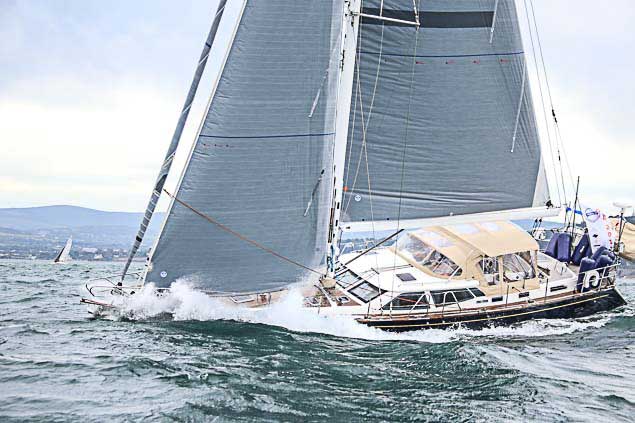 Never mind the weather, the tent is up and setting a treat…..Unlike the Mini-Transat boats which crossed the Atantic two weeks in advance of them, the crew of former Round Ireland winner Eamon Crosbie’s Discovery 55 Pamela will be enjoying considerable comfort during the ARC 2018. Photo David O’Brien/Afloat.ie
Never mind the weather, the tent is up and setting a treat…..Unlike the Mini-Transat boats which crossed the Atantic two weeks in advance of them, the crew of former Round Ireland winner Eamon Crosbie’s Discovery 55 Pamela will be enjoying considerable comfort during the ARC 2018. Photo David O’Brien/Afloat.ie
Then when the huge ARC 2017 got its incredibly varied fleet lumbering away last weekend, again from Gran Canaria, this time towards St Lucia, we tried to take an overview of the fleet, but inevitably became focused on Eamon Crosbie’s Discovery 55 Pamela from Dun Laoghaire with a merry crew on board. We’ve been observing that, like the rest of the fleet, she has found anything but regular northeast tradewinds out in the Atlantic, but she’s getting there nevertheless – race tracker here
This weekend, there’s some quite heavy metal – some of it distinctly luxurious in tone – getting started in the RORC’s Transatlantic Race from Lanzarote, with the finish in Grenada. The fleet of 23 make up in quality what it lacks in quantity, for though the smallest boat is the JPK 10.10 Jangada, the largest is Daniel Stump’s Southernwind 96 Sorceress, while the longest is Ludde Ingvall’s uber-skinny 98ft Maxi CQS from Australia.
It’s aboard this extraordinary yoke that Ireland’s Sailor of the Year 2013 David Kenefick, now 26, is sailing as skipper. In an acknowledgement to the sheer power and reach of the French sailing scene, the young Cork sailor had been declared “Rookie of the Year” in the Figaro Solo circuit in 2013, and to the surprise of some of the more traditionally-minded adjudicators, this was seen by the sailing public as more important than some major achievements within Ireland, so four years ago Kenefick became their Number 1.
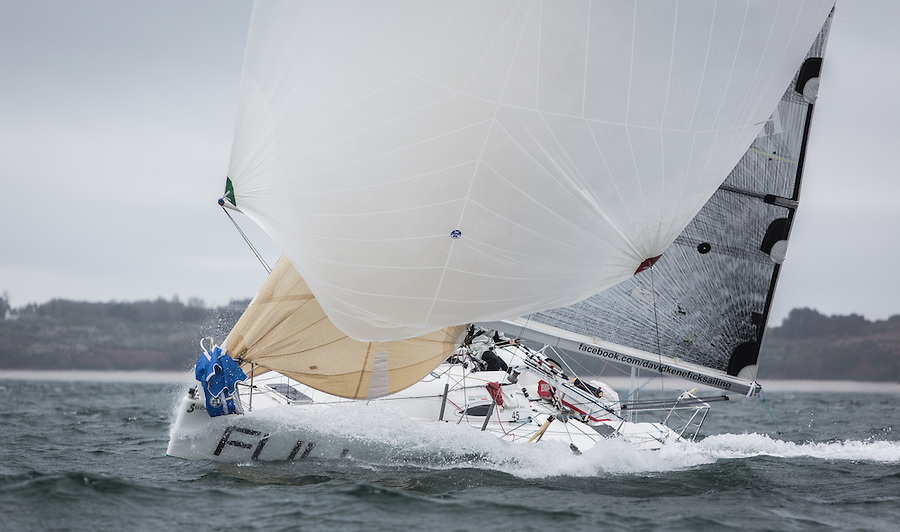 Somewhere in there on his Figaro Solo is David Kenefick, Ireland’s “Sailor of the year” 2013. Photo: Brian Carlin
Somewhere in there on his Figaro Solo is David Kenefick, Ireland’s “Sailor of the year” 2013. Photo: Brian Carlin
"Ludde is a legend and it is a great privilege to sail with him as skipper of CQS,” commented Kenefick. We have a young and multinational crew and we cannot wait to take on the challenge. CQS is a fantastic race boat and I am sure we are all going to learn so much after 3,000 miles.”
“In my early days I had the pleasure of racing with Harold Cudmore and we are still great friends,” said Ludde Ingvall. “I remember meeting with Harold and asking him what drives us on, now that we have been racing so many years. He replied we must 'pass it on' and that is what we are doing for young sailors that show great ability and the attitude to succeed.”
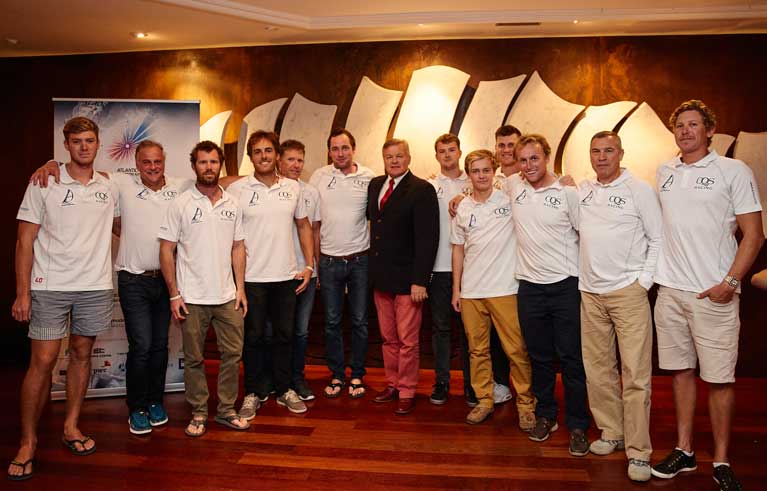 CQS crew – 26 year old Dave Kenefick pictured (centre) with Ludde Ingvall at tne gala dinner and his Australian 98ft Maxi CQS in the RORC Transatlantic Race starting from Lanzarote. Also pictured (fourth from left) is Royal Ulster Olympian James Espey
CQS crew – 26 year old Dave Kenefick pictured (centre) with Ludde Ingvall at tne gala dinner and his Australian 98ft Maxi CQS in the RORC Transatlantic Race starting from Lanzarote. Also pictured (fourth from left) is Royal Ulster Olympian James Espey
It will be intriguing to learn from one of our own just what it’s like to sail on something like CQS, which you can see as either counter-intuitive, or else so very intuitive that she has come out the other side. And with Kenefick on board, we will be keeping a special eye on her showing as the longest boat.
In between CQS and the “little” Jangada, there’s an eclectic selection including that old war horse, the Volvo 70 Monster Project (Roman Guerra). But generally they’re top end boats of comfortable size while being competitive at the same time. And with a considerable emphasis on European entries (there are boats from nine countries), they’re living proof that the story of the Eurozone’s economic recovery is true, and it’s out there and floating on the Atlantic.
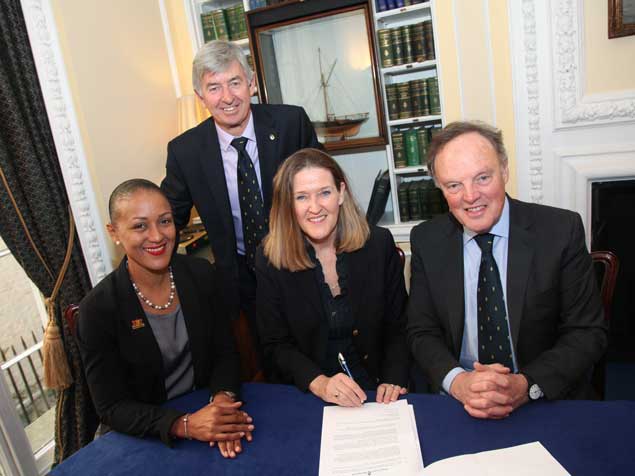 At the signing of the agreement to stage the RORC Transatlantic race from Lanzarote to Grenada are (left to right) Francine Stewart (Marketing Manager, Grenada Tourism Authority), Eddie Warden-Owen (CEO, RORC), Patricia Maher (Grenada Tourism Authority) and Michael Boyd (Commodore, RORC)
At the signing of the agreement to stage the RORC Transatlantic race from Lanzarote to Grenada are (left to right) Francine Stewart (Marketing Manager, Grenada Tourism Authority), Eddie Warden-Owen (CEO, RORC), Patricia Maher (Grenada Tourism Authority) and Michael Boyd (Commodore, RORC)
Typical of this is hyper-keen French owner-skipper Eric de Turkheim from La Rochelle, who we also feel is one of us, for if it hadn’t been for Rambler 88’s almost freakish performance in last year’s Volvo Round Ireland Race, his unusual-looking but effective Teasing Machine II would have been the overall winner.
Since then he has come up with the new 54ft Teasing Machine III, and though she wasn’t ready in time for the Fastnet Race in August, she made an impressive debut in the Middle Sea Race in late October, and would have been second overall if another of those pesky JPK 10.80s, this time the Russian-owned Bogatyr, hadn’t come out of the woodwork at the end, and snatched the win by six minutes, while Teasing Machine II was relegated to a close third overall.
So between CQS and Teasing Machine, we have favourites to follow. And although the RORC fleet start all of a week after the ARC, the winds along the sunshine route to the Caribbean are in such a wayward mood that it’s going to be fascinating comparing the relative performance of the two groups.
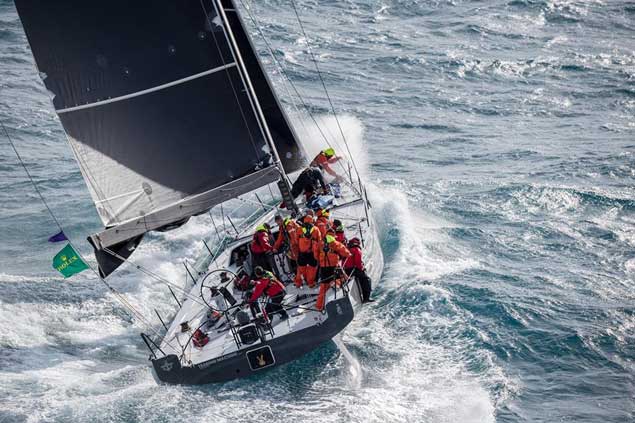 The new 54ft Teasing Machine II on her way to third overall in her first major event, the Rolex Middle Sea Race 2017. Photo Rolex
The new 54ft Teasing Machine II on her way to third overall in her first major event, the Rolex Middle Sea Race 2017. Photo Rolex
But what on earth, you might well wonder, is all this recitation of Atlantic voyagers and racers to do with giving only two instead of three cheers for the prospect of World Sailing shoe-horning offshore racing into the Olympics?
It’s simple. Offshore racing and its many organisations and events are so varied that trying to channel them into the narrow perspective of the Olympics, with its over-long four year cycle, is going to result in a very artificial construct. And the idea of having a man-and-woman crew of two who are declared to be the World Champions and Olympic Gold Medallists is so remote from the delicious, invigorating and multi-interest variety of the current offshore and ocean scene that we could be talking about two different planets.
For sure, it’s a notion which will appeal to newspaper headline writers. In the real red-top trade, sailing only makes sense when it’s in the Olympics or somebody is drowned. Beyond that, it’s simply too complex, varied and – let’s face it – self-absorbed, to promote itself as some sort of arena sport.
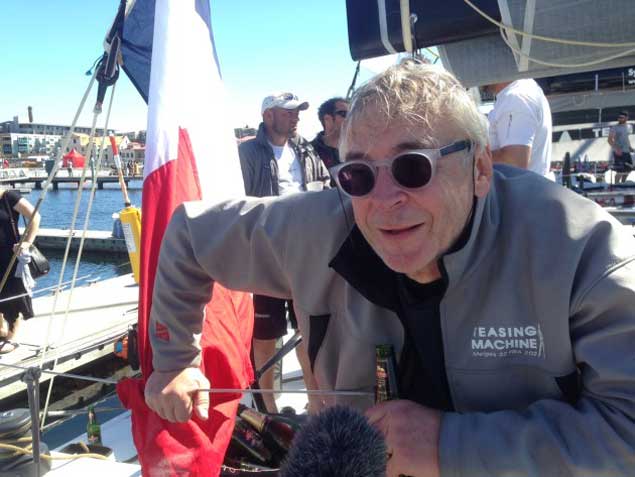 Eric de Turkheim, popular owner of Teasing Machine III, in Sydney preparing to race Teasing Machine II with success in the Sydney-Hobart Race
Eric de Turkheim, popular owner of Teasing Machine III, in Sydney preparing to race Teasing Machine II with success in the Sydney-Hobart Race
It was quite some time ago when two top honchos in American sailing announced that they were determined to reduce the number of world titles recognized by the then International Yacht Racing Union, which went on to become ISAF, and is now World Sailing. Back in the day, these guys reckoned that the 143 different IYRU-recognised classes with International status being each entitled to their own World Championship was a nonsense, and numbers should be reduced.
You can see why they thought so. One hundred and forty three sailing world champions might seem a bit over the top. But the idea went down like a lead balloon. People cherish their own classes, they cherish their own world titles, and they cherish their own local setup. And though they take a polite interest in World Sailing’s new look World Championship for Olympic classes, as it so often seems to be held on the other side of the world they’ll only engage if they happen to know of someone taking part.
So it’s complicated enough with inshore racing. But when you add in the extra factors involved in the much more complex and quirky world of offshore and ocean racing, it sometimes goes beyond understanding.
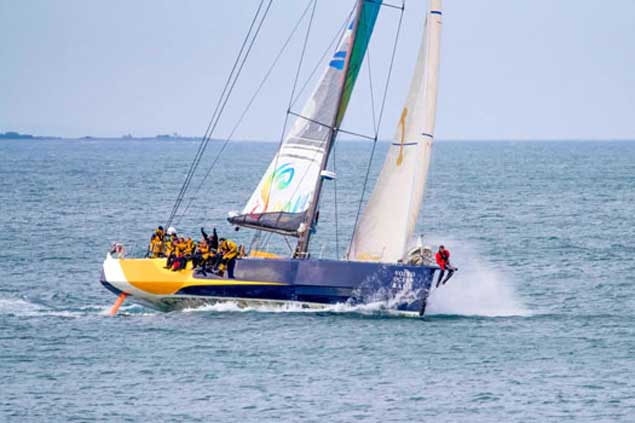 The old war horse. The Volvo 70 Monster Project coming to the finish to take line honours in the 2014 Round Ireland Race. She’s still going strong, and is one of the entries in the RORC Transatlantic Race. Photo WSC
The old war horse. The Volvo 70 Monster Project coming to the finish to take line honours in the 2014 Round Ireland Race. She’s still going strong, and is one of the entries in the RORC Transatlantic Race. Photo WSC
Yet the way things are provides something for everyone in the audience. While we pay lip service to approving the moves towards synchronising the IRC and ORC measurement systems, there’s a little bit of us that thinks it’s actually a pretty good idea having the two, as it allows for even more prizes, and they keep up the interest across a broader spectrum of the fleet.
Equally, an almost mind-numbing variety of events and organisations, a whole world away from the rigid one design format proposed for the Olympics offshore racing tryout, is what the global scene in the offshore game is all about. Think, for instance, of the 240 people from both sides of St George’s Channel who gathered at the Irish Sea Offshore Racing Association’s annual black tie dinner and prize-giving earlier this month in the National Yacht Club. All power to the great Peter Ryan for organising it, these were genuine sportsmen and women who are dedicated to their interest afloat, yet somehow trying to link them directly to the sterile world of the Olympics just doesn’t make sense.
At the other extreme, our own deservedly admired 2016 Olympic Silver Medallist Annalise Murphy instantly made herself much more interesting, much more of a three-dimensional character, when she courageously took on the crewing job aboard Turn the Tide on Plastic in the Volvo Ocean Race. There’s no doubt that having the fitness of an Olympic athlete is a real asset in a Volvo 65, but the concept of the Volvo Ocean Race is a million miles from Olympic theory.
In a different direction, sailing also includes the craziness of the America’s Cup, but in the offshore and ocean sphere, it’s generally agreed that the supreme event is the Vendee Globe. Nothing could be simpler in concept than one sailor on his or her own racing non-stop round the world out of a French port which finds it has stumbled on a world-beating event. Yet nothing is more complex than the actual machinations of the Vendee Globe, but the Olympic ideal it ain’t.
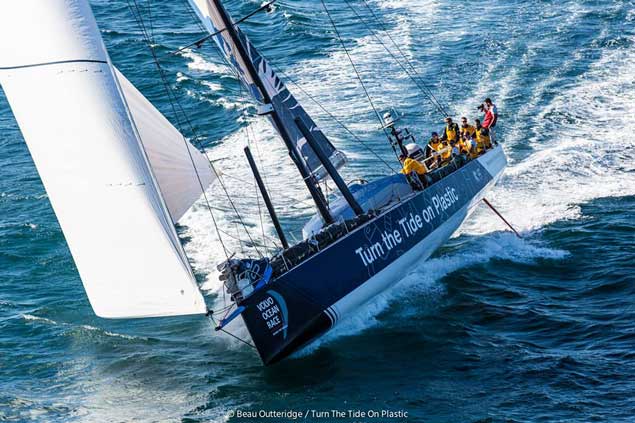 A very different machine from a Laser Radial – Silver Medallist Annalise Murphy is one of the round the world crew on turn the Tide on Plastic
A very different machine from a Laser Radial – Silver Medallist Annalise Murphy is one of the round the world crew on turn the Tide on Plastic
But despite these enormous difference, the fact of offshore racing becoming linked to the Olympics might make life a little easier for people like Tom Dolan who have literally re-invented themselves in the strange world of solo offshore racing, but find it extremely difficult to explain to non-sailors, especially those who might have a sponsorship budget, just what’s going on. However, mention the Olympics, and it’s a bit of a light-bulb moment.
That said, the proposed Olympic offshore course will be light years away from what Tom Dolan and his comrade-rivals put themselves through during the first 15 and more days of November. We carried an extract of winner Erwan Le Daroulec’s take on it earlier this week, but it’s worth repeating (and don’t sign off, the real meat of this week’s blog is at the end). Le Draoulac wrote:
“I brought a book with me, but I never thought to read it. I helmed, I ate, I slept, I answered the calls of nature, a real animal life. It was a nightmare.
The boat was soaked the whole time. I never dumped any sails, I just went up forward to reinforce my bowsprit. To get to sleep when I was under autopilot, I put on my headphones with some audio books and I listened again to the whole of Harry Potter. It was the only way of preventing stress whilst the boat was powering along at 18 knots, sometimes under autopilot, but I never eased off the pace.
It was only in the last two days where I dropped the large spinnaker in the squalls. I said to myself that it would be too silly to break everything so close to the goal. Prior to that though I really attacked hard. I knew I was risking a dismasting, but my line of thinking was that I was only twenty years old and that I’d have the opportunity to do another Mini-Transat. I didn’t make the most of it, I didn’t enjoy it. I’d like to the cross the Atlantic again, but gently so as to make the most of it.”
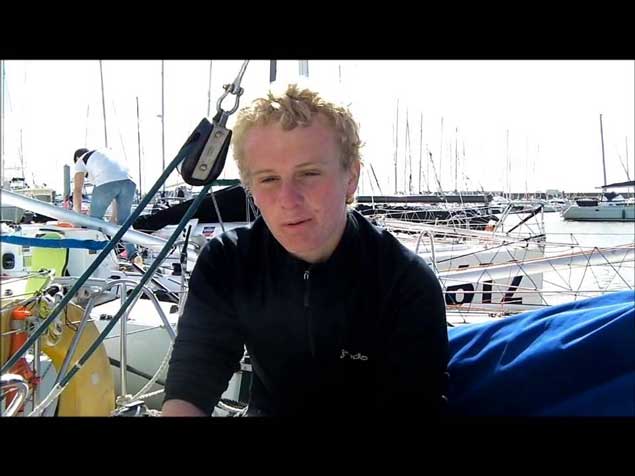 Erwan le Draoulec – he won, and won well, but says he didn’t enjoy it at all
Erwan le Draoulec – he won, and won well, but says he didn’t enjoy it at all
We really must try a dose of the old Harry Potters the next time insomnia comes along…..but seriously, what sort of a sailing world have we created, that a 20-year-old old is trained to such a level of performance that he can turn in an incredibly brave and skilled world-beating performance, yet actually hates every minute of it?
That said, Tom Dolan reckons he only feels truly alive when he’s “in the zone”, racing his little boat flat out. However, since he finished he has quietly revealed that, two days out from the finish, he survived an experience which was beyond fulfilling.
He was running in the dark in about 30 knots of wind and going a dream under the small spinnaker, nicely on track for fourth with a good chance of a bite at third, when out of the still-total blackness a 45 knot squall struck. IRL 910 went faster and faster, then a steep one lifted her from astern, and the tip of her stemhead went under the bow-wave. Within seconds, she’d done a complete pitchpole.
Tom found himself in the water in the dark, and his boat inverted for what seemed forever beside him. But she shook herself upright, he hauled himself aboard, and to his amazement everything, rig and all, still seemed intact. It was the first time he’d ever heard of a Min-Transat boat pitch-poling and not being dismasted, and miraculously it had happened to an under-funded Irishman who was campaigning on little more than wing and a prayer. He still had his wing. He will have sent have up a little prayer of thanks.
Then it was right back full on into the race, and we’ve all seen the vid of him finishing. But it’s worth repeating. You’re looking at a real hero.
He was within 48 minutes of being third and on the podium, but it was miraculous he was there at all. As for the final overall placings based on the total accumulated times for the two legs, the word is that won’t be officially announced until the Paris Boat Show on December 8th, when they’ll also stage the prize-giving.
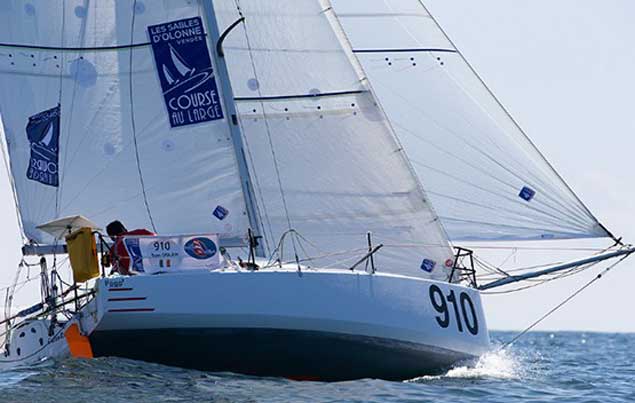 Tom Dolan with his new boat in 2016, when he won his first race. It has been revealed that he came fifth in the second leg of the Mini Transat despite being pitch-poled two days before the finish
Tom Dolan with his new boat in 2016, when he won his first race. It has been revealed that he came fifth in the second leg of the Mini Transat despite being pitch-poled two days before the finish
At the Paris Boat Show they’ll also officially announce the Golden Globe 18, golden oldies of a past era racing round the world in celebration of the Golden Jubilee the original Golden Globe, the non-stop round the world solo race of 1968 which was won by Robin Knox-Johnston in Suhaili. To be eligible, you have to be racing a “closed profile” (ie non fin-and-keg) boat of around 36ft, and Ireland’s Gregor McGuckin is entered with a Biscay 36 which he is currently preparing.
But as the organisers couldn’t get any British port associated with the original race to take it on fifty years later, Les Sables d’Olonne in France, home of the Vendee Globe, stepped up to the plate, and they will be the host port. It’s a perfect illustration of the huge spread of French interest in offshore racing. In fact, you might be making a sensible wager if you bet on France to support the new offshore event in the Olympics, but only if they can present the medals at the subsequent Paris Boat Show…
Meanwhile, as to Ireland being ready and willing for involvement in an Olympic offshore racing class, we certainly have plenty of keen young ocean racers, both men and women, who will be mustard keen if the resources can be found to get their campaigns under way. But as it is, the world of offshore racing is already rich in its diversity without being forced into any Olympic straitjacket. And that’s the way it is in Ireland too. We seem to like it that way too, but if the Olympics come calling, they’ll be welcome to join the party.
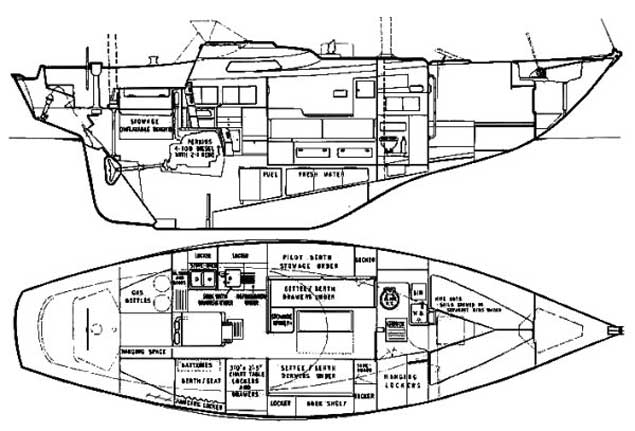 Tough and compact – the hull profile of a vintage Biscay 36. Ireland’s Gregor McGuckin will be racing one in next year’s Golden Jubilee of the Golden Globe Race. But despite the original having started and finished in England, the 2018 version will start and finish in France
Tough and compact – the hull profile of a vintage Biscay 36. Ireland’s Gregor McGuckin will be racing one in next year’s Golden Jubilee of the Golden Globe Race. But despite the original having started and finished in England, the 2018 version will start and finish in France
107 Yachts for Sydney Hobart Race
The 73rd Rolex Sydney Hobart promises much, with 107 yachts currently scheduled to cross the start line in Sydney Harbour at 13.00 (AEDT) on 26 December. Some 30 international entrants will participate, with a high-profile battle for line honours and fierce contest for the overall win expected. The 628-nautical mile race has never yet failed to deliver intense drama and great spectacle - the 2017 edition looks set to be no exception. First held in 1945, the Sydney Hobart is organised by the Cruising Yacht Club of Australia with the cooperation of the Royal Yacht Club of Tasmania. Rolex has been title sponsor since 2002. An unquestionably iconic sporting challenge, the race sits alongside the other offshore classics, such as the Rolex Fastnet Race and Rolex Middle Sea Race, that underpin the Swiss watchmaker’s association with the sport.
First held in 1945, the Rolex Sydney Hobart is organized by the Cruising Yacht Club of Australia with the cooperation of the Royal Yacht Club of Tasmania. Rolex has been title sponsor since 2002. An unquestionably iconic sporting challenge, the race sits alongside the other offshore classics, such as the Rolex Fastnet Race and Rolex Middle Sea Race, that underpin the Swiss watchmaker’s association with the sport.
LEADING LIGHTS
Last year, a four-way competition to finish first in Hobart resulted in a record-breaking performance by Perpetual LOYAL. Anthony Bell’s 100-foot Maxi rewarded her crew’s persistence and resolve, as man and machine combined to take nearly five hours off the previous fastest time.
Once again, four 100-foot powerhouses are in the running. Wild Oats XI will be seeking to re-establish her benchmark status by adding to her eight line honours successes and taking back the record, weather permitting. Against her, the American Maxi Comanche, first to finish in 2015, is competing under the stewardship of New Zealander Neville Crichton, a two-time line honours winner himself.
Peter Harburg’s Black Jack is the former Alfa Romeo – the fastest yacht in 2009 with Crichton. The Reichel/Pugh design has spent the past five years dominating the northern hemisphere big boat scene. Completing the quartet is Christian Beck’s InfoTrack (previously Perpetual LOYAL).
Racing these highly-tuned Maxis at full tilt over some of the most difficult seas in the world is a true test for both crew and yacht. Any weakness in organization, skill or determination will be ruthlessly exploited by the opposition and the conditions. Preparation is critical and one month out from the start, the race has already begun in earnest for the owners and crews of these pure thoroughbreds.
PEER PRIDE
Away from the rarefied atmosphere of the 100-footers, the majority of entrants are competing for a variety of reasons. Some are relatively simple: a passion for the sport, the camaraderie of teamwork or the opportunity to pit oneself against the challenge. There are prizes throughout the fleet, with classes separated into different bands under handicap. At the finish in Hobart, Tasmania though, one boat will stand head and shoulders above the rest. The crew that wins overall will receive the deserved recognition of their peers and take a place in event legend. Beyond these less tangible rewards, there are the coveted Tattersall’s Cup, with its many years of history, and the Rolex Oyster Perpetual timepiece, engraved with the race name, the year and the words “Overall Winner”.
Over the past fifteen years, the title and rewards have been shared across the fleet, with yachts in the 40 to 50-foot range winning five times and yachts between 50 and 60 feet also winning five times. There have been three wins from the 60 to 70 feet yachts and two wins from the 100 footers. The prevailing weather will be significant in determining the outcome of the race. Inevitably, the conditions favour different lengths of yacht at different times; the strength of the wind and the state of the sea play critical roles. Crews must manage their resources astutely and sail to their yacht’s full potential throughout the period at sea. Complacency and inattentiveness can be ruinous.
FORM BOOK
The 2016 overall winner is back, although in new hands and renamed Wizard. David and Peter Askew from the United States will have their work cut out to repeat the achievement of Jim Delegat and the crew of Giacomo. The last boat to secure back-to-back wins was Freya in 1965. Bob Steel, from New South Wales and owner of Quest, will be hoping the conditions suit the 50-footers. A winner in 2002 and 2008, his current boat also triumphed under the name Balance in 2015. Steel, too, is up against it. This segment of the fleet is full of pedigree. Italian yacht, Mascalzone Latino owned by Vincenzo Onorato, enters after back-to-back wins in her last two 600-mile outings: the 2017 Hong Kong to Vietnam Race and the 2016 Rolex Middle Sea Race.
Chris Opielok from Germany, owner of the TP52 Rockall, may be relatively unknown at this race but he is a proven offshore challenger winning the Admiral’s Cup twice. American Joseph Mele will continue his pursuit of bluewater racing’s greatest prizes. Fresh from participation at this year’s Rolex Fastnet and Rolex Middle Sea Race, Mele and his Triple Lindy team are entering their second successive Rolex Sydney Hobart.
A NOD TO HISTORY
The 52-foot Dorade will debut at the Rolex Sydney Hobart, some 80-plus years after making a name for herself winning some of the world’s classic races. Current owners, Matt Brooks and Pam Rorke Levy, have undertaken an ambitious itinerary in recent years, believing Dorade was born to race in open water and should continue to do so despite her advancing age. The same philosophy could equally apply to Sean Langman, whose Maluka is another octogenarian yacht to take the course; although, in Langman’s case, this has become something of a tradition. Kialoa II will also raise a cheer; a line honours winner at the Rolex Sydney Hobart in 1971, she is on a journey to revisit the scenes of past glories in the hands of Patrick and Keith Broughton. Though the prospects for repeating former triumphs are slim, all three crews will surely win hearts and minds of spectators and crew for their spirit and endeavour.





























